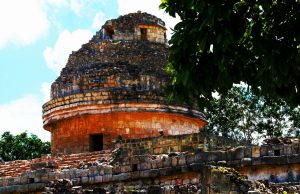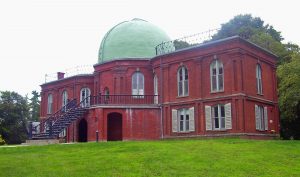It seems that humanity has always been fascinated by the night sky. Across the globe, archaeologists have found records of people analyzing the movements of the heavens and using those movements to measure time and to signify important cultural events. While the specific reasons for the study of the cosmos has changed over time, one thing has remained constant: the use of observatories. While the methods and materials used for building observatories have changed, their overall appearance has changed very little.
A prime example of this is El Caracol, found in the ancient Mayan city of Chichén Iztá. This stone observatory was built on the southern side of the city and was rebuilt several times. Archaeologists believe the final version was erected between 900-1000 A.D. The observatory was used to track the movement of the sun and certain planets. The observers seemed to be especially interested in the movement of Venus, as an entire floor of the two-story observatory is dedicated to tracking its movement. The observatory also allowed the Mayans to tell when the sun reached its zenith. This mattered to the Mayans, as the rainy season starts right after the sun reaches its zenith in May. Knowing when the sun reached this point allowed the Mayans to make sure their fields were ready for the rain. They also viewed the planets as embodiments of the gods, so their movement was of religious significance to the Mayans. While the observatory was built using ancient methods and is comprised entirely of stone, its overall structure is similar to that of modern observatories, with a domed roof that allowed for viewing at all angles, and its positioning at a high point in the landscape.
As time went on, observatories shifted from having religious and agricultural significance to being more heavily based in scientific discovery. This is the case for the Vassar College Observatory. Completed in 1865, the observatory was used as both the home and observatory of Maria Mitchell, the first professional female astronomer. The observatory was used to study telescopic moments, along with the planets Jupiter and Saturn. Unlike El Caracol, the Vassar College Observatory is comprised of mostly brick, with the dome being made of metal. The observatory also has a telescope, a commodity not invented until 1608.
Even in modern day, observatories continue to maintain the same basic appearance. However, they have changed quite dramatically in the scope of both their reach and potential. One example of this is the Mount Graham Observatory. Built to research exoplanets and to analyze the dust around stars. While maintaining a similar shape to both El Caracol and the Vassar College Observatory, it not only has a cube shaped top rather than a dome, but it has two telescopes rather than one.
Sources:
Miller, Julia. The Caracol, or Observatory of Chichén Itzá. Yucatan Today. Accessed September 17th, 2017. http://yucatantoday.com/caracol-or-observatory-chichen-itza/?lang=en.
Maria Mitchell. Vassar Encyclopedia. Accessed September 17th, 2017. http://vcencyclopedia.vassar.edu/faculty/original-faculty/maria-mitchell1.html
Vassar College Observatory. National Park Service. Accessed September 17th, 2017. https://www.nps.gov/places/vassar-college-observatory.htm
Beal, Tom. Huge Mount Graham telescope finally paying off. The Arizona Daily Sun. Accessed September 17th, 2017. http://azdailysun.com/huge-mount-graham-telescope-finally-paying-off/article_116733a4-fdd4-592f-a256-cb9c5f1bcbeb.html
Picture sources:
Wikimedia Commons. Accessed September 17th, 2017. https://commons.wikimedia.org/wiki/File:Vassar_College_Observatory.jpg
EL Caracol, The Observatory of Chichén Itzá. Atlas Obscura. Accessed September 17th, 2017. http://www.atlasobscura.com/places/el-caracol-chichen-itza-mexico
Beal, Tom. Huge Mount Graham telescope finally paying off. The Arizona Daily Sun. Accessed September 17th, 2017. http://azdailysun.com/huge-mount-graham-telescope-finally-paying-off/article_116733a4-fdd4-592f-a256-cb9c5f1bcbeb.html




Is the case of looking at the observatory one where form meets function? is there any situation in which observatories throughout time show contrast to this general shape and build? where are observatories in the archaeological record usually located? did everyone have access to them?
With observatories, it is indeed a case of form meets function. Most observatories are tall and cylindrical with a domed top to allow for the best possible viewing of the night sky. The observatory’s height allows it to be able to see over other buildings and features of the land, which would obscure the view of the night sky. This is also why most observatories in the archeological record are found on top of mountains, hills, or some other raised point in the landscape. The observatory’s cylindrical shape and domed top create a perfect half-sphere of viewing, allowing for the entire horizon to be seen by the observer. However, there are exceptions to this rule. Some observatories do not abide by these rules. One example of this is Stonehenge, located in Wiltshire, England. While it is located on a hill and is circular, it is a grouping of stones rather than a building, meaning it is neither tall nor cylindrical. The horizon is completely seen due to the lack of walls, and height is not needed due to its placement and lack of buildings around it. Another example of this is Newgrange in County Meath, Ireland.While it is also located on a hill and is circular, the building is short and domed. The reason for this is that Newgrange was used only for observing and signaling the winter solstice. Both Stonehenge and Newgrange were used for observing solstices and equinoxes, which were important events for ancient people. This was also the use for most other ancient observatories. But while their purpose was the same, who could access them differed. While some places like Stonehenge were probably visited by many people, other observatories were most likely mostly used by priests. This was usually due to the observatory doubling as a temple, as observing the sky was thought to be a method of seeing the will of the gods. The stars and night sky were significant to the mythologies of many ancient cultures, such as the Greeks and Maya. As a result, many observatories were probably only used by priests, who used the observatory to view the night sky and keep track of events that were important to the culture, such as equinoxes and solstices. They would then communicate their findings to the rest of the civilization, who would use the findings as needed, such as farmers planting or harvesting their crops. As time went on, priests were slowly replaced with scientists, who with better and better telescopes, started looking further into the depths of the night sky. Many observatories were still accessible to the common folk, but many others were exclusively used by scientists. This is still true today around the world, as many observatories are used by scientists to learn more and more about our universe. These scientists then show their findings to the “common folk”, as priests did back in ancient times.